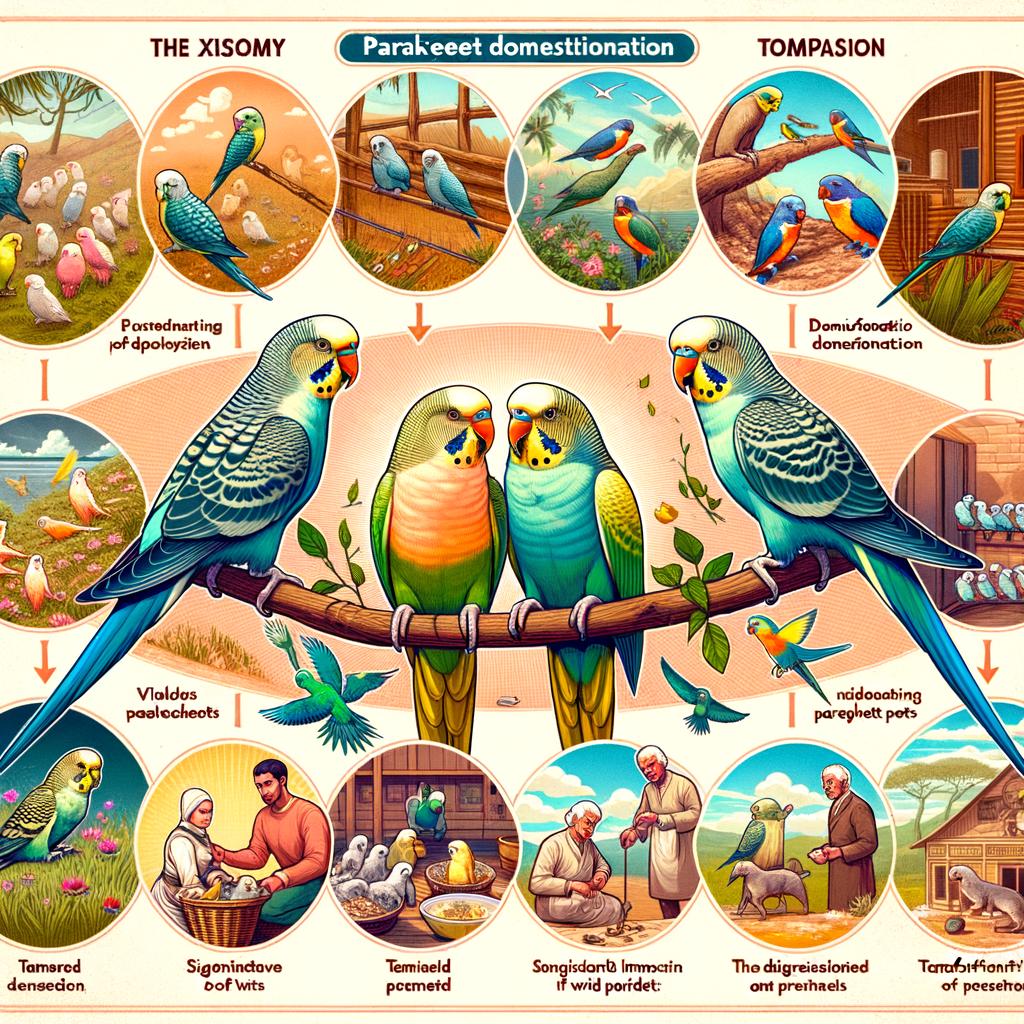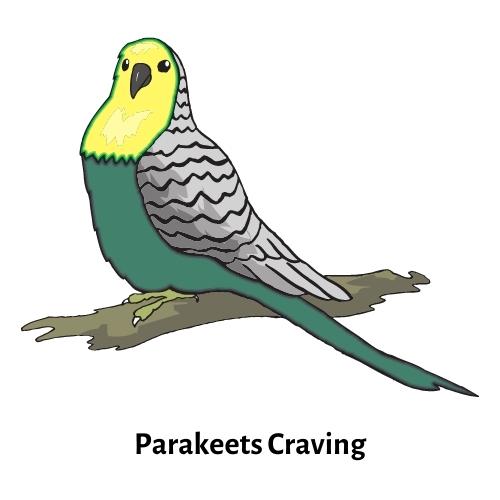
Introduction to Parakeet Domestication
Parakeets, also known as budgies, are one of the most popular pet birds worldwide. Their bright colors, playful nature, and ability to mimic human speech make them a delightful addition to any household. But have you ever wondered how these wild birds became domesticated pets? In this section, we will delve into the concept of domestication and the importance of parakeet domestication.
- Understanding the concept of domestication
- Importance of parakeet domestication
Domestication is a process that takes place over many generations. It involves humans selecting and breeding animals with desirable traits. Over time, these animals become different from their wild counterparts, both in appearance and behavior. They become more suited to living alongside humans, often becoming dependent on us for food and care.
Parakeet domestication has many benefits. For one, it allows us to enjoy the company of these charming birds in our homes. Domesticated parakeets are also easier to care for than their wild counterparts. They are more accustomed to human presence, less likely to fly away, and more capable of learning tricks and mimicking speech.
Moreover, domestication has also helped protect parakeets. In the wild, these birds face numerous threats, including predators, disease, and habitat loss. By domesticating parakeets, we can provide them with a safe and comfortable environment, free from these threats.
In the following sections, we will explore the history of parakeet pets, their journey from the wild to our homes, and the broader perspective of bird domestication. We will also delve into the evolution of parakeets as pets, their breeding history, and the different species of domesticated parakeets. So, stay tuned to learn more about these fascinating creatures!
History of Parakeet Pets
Parakeets, also known as budgies, have been charming humans with their vibrant colors and playful personalities for centuries. Let’s delve into the fascinating history of these feathered friends as pets.
- Early History of Parakeet as Pets
- Evolution of Parakeet Pet Culture
The story of parakeets as pets begins thousands of years ago. Ancient Egyptians were among the first to keep parakeets as pets. They admired these birds for their bright colors and cheerful chirping. In fact, parakeets were so loved that they were often depicted in ancient Egyptian art and hieroglyphics.
Fast forward to the 1800s, parakeets were brought to Europe from Australia. Their vibrant colors and friendly nature quickly made them popular pets. Queen Victoria of England herself was known to have a pet parakeet, which further boosted their popularity.
Over time, the culture of keeping parakeets as pets has evolved significantly. In the early 20th century, parakeets were often kept in small cages and were seen more as decorative objects than companions. However, as our understanding of these intelligent birds grew, so did our approach to their care.
Today, parakeets are recognized for their intelligence and sociability. They are often kept in larger cages or aviaries, given plenty of toys for mental stimulation, and even trained to perform tricks or mimic human speech. Parakeet owners are encouraged to spend time interacting with their pets daily, fostering a bond that can be as close as that between a dog and its owner.
From ancient Egypt to modern homes, the journey of parakeets as pets is a testament to their enduring appeal. Whether you’re a seasoned bird owner or considering getting a parakeet for the first time, understanding their history can deepen your appreciation for these delightful birds.
Wild to Pet Parakeets: A Journey
When we think of parakeets, we often imagine these vibrant, chatty birds as our beloved pets. However, the journey from wild to pet parakeets is not as simple as it seems. It involves a series of challenges and requires a deep understanding of their behavior and the right taming methods.
Initial Challenges in Taming Wild Parakeets
Taming wild parakeets is a task that requires patience and understanding. There are two main challenges that one needs to overcome in this journey:
- Understanding Parakeet Behavior
- Methods Used for Taming
Parakeets are social birds that thrive in a flock. In the wild, they communicate and interact with each other, which is a behavior that they carry into domestication. Understanding their behavior is crucial for successful taming. For instance, they are known for their morning and evening ‘chatter’ sessions, which is their way of socializing. Recognizing and respecting these behaviors can help in building a bond with them.
The second challenge is finding the right method to tame them. It’s important to remember that each parakeet is unique and what works for one might not work for another. Some common methods include gentle handling, positive reinforcement, and creating a safe and comfortable environment. However, it’s crucial to be patient and consistent in your efforts.
Overcoming these challenges is the first step in the journey of turning a wild parakeet into a pet. It’s a rewarding process that requires time and dedication, but the result is a beautiful bond between you and your feathered friend.
Success Stories of Taming Wild Parakeets
Now that we’ve discussed the initial challenges in taming wild parakeets, let’s delve into some inspiring success stories. These case studies will provide you with a better understanding of the journey from wild to pet parakeets.
- Case Study 1: The Story of Bella
- Case Study 2: The Transformation of Max
Bella was a wild parakeet who was found injured in a park. A kind-hearted individual, Sarah, took Bella home and began the process of taming her. Sarah started by creating a safe and comfortable environment for Bella, ensuring she had plenty of food and water. Gradually, Bella began to trust Sarah. Sarah used positive reinforcement techniques, rewarding Bella with treats when she behaved well. After several months, Bella was completely tame and had become a beloved part of Sarah’s family. This story highlights the importance of patience and consistency in taming wild parakeets.
Max was a wild parakeet who was initially very aggressive. His new owner, John, faced many challenges in taming him. John started by observing Max’s behavior to understand his likes and dislikes. He then used these insights to build a bond with Max. For example, John noticed that Max loved a particular type of fruit, so he used this fruit as a reward during training sessions. Over time, Max’s aggression lessened, and he began to trust John. Today, Max is a friendly and affectionate pet. This case study demonstrates that understanding a parakeet’s behavior is crucial for successful taming.
In conclusion, taming wild parakeets is a challenging but rewarding journey. It requires patience, understanding, and a commitment to building a bond with the bird. However, as these case studies show, the result is a loving and loyal pet that brings joy and companionship.
Domestication of Birds: A Broad Perspective
The domestication of birds is a fascinating subject, spanning across various species and cultures. Let’s delve into the world of bird domestication, focusing on three popular bird species that have been tamed by humans for centuries: Parakeets, Canaries, and Parrots.
Domestication of Various Bird Species
Each bird species has a unique journey from the wild to our homes. Let’s explore the domestication process of Parakeets, Canaries, and Parrots.
-
Parakeets
Parakeets, also known as budgerigars or budgies, are native to Australia. They were first domesticated by the indigenous people of Australia over 4,000 years ago. Known for their vibrant colors and playful nature, Parakeets have become one of the most popular pet birds worldwide.
-
Canaries
Canaries were first domesticated in the 17th century on the Canary Islands, hence their name. They were bred for their melodious song, leading to various song breeds. Today, Canaries are cherished for their beautiful song and bright yellow plumage.
-
Parrots
Parrots have been domesticated for thousands of years, with evidence of their presence in ancient Greek and Roman societies. Known for their intelligence and ability to mimic human speech, Parrots are a beloved pet in many households.
Understanding the domestication of these bird species helps us appreciate their unique characteristics and the role they play in our lives. Whether it’s the playful Parakeet, the singing Canary, or the intelligent Parrot, each bird brings joy and companionship to our homes.
Impact of Bird Domestication on Human Society
Domestication of birds, particularly parakeets, has had a profound impact on human society. This influence can be seen in two major areas: culture and tradition, and economy and trade.
- Role of Domesticated Birds in Culture and Tradition
- Impact on Economy and Trade
Over the centuries, domesticated birds have played a significant role in various cultures and traditions. Parakeets, for instance, are often associated with love and happiness in many societies. They are seen as symbols of joy and are often featured in art, literature, and folklore.
For example, in ancient Greece, parakeets were believed to be the birds of Aphrodite, the goddess of love. In Native American culture, parakeets are seen as messengers of good news. These cultural associations have helped to shape human perceptions and attitudes towards these birds, leading to their widespread domestication.
Domesticated birds have also had a significant impact on the economy and trade. The breeding and sale of parakeets and other domesticated birds have become a lucrative business in many parts of the world. This industry contributes to the economy by creating jobs and generating income.
For instance, in the United States, the pet bird industry is worth over $1 billion annually. This includes the sale of birds, bird food, cages, toys, and other related products. The trade of domesticated birds also plays a role in international commerce, with birds being exported and imported between countries.
| Country | Annual Revenue from Bird Trade (in USD) |
|---|---|
| United States | $1 billion |
| United Kingdom | $300 million |
| Australia | $200 million |
As you can see, the domestication of birds, particularly parakeets, has had a profound impact on human society. From shaping our culture and traditions to contributing to our economy, these feathered friends have become an integral part of our lives.
Parakeet History: From Wild to Domesticated
Parakeets, with their vibrant colors and melodious chirping, have been a beloved pet for centuries. But have you ever wondered how these birds transitioned from the wild to our homes? Let’s take a journey through the fascinating history of parakeet domestication.
- Historical timeline of parakeet domestication
- 2500 BC: Ancient Egyptians were known to keep birds as pets, including parakeets.
- 1500s: European explorers brought parakeets back from their voyages to the New World.
- 1800s: Parakeets became popular pets in Victorian England, with Queen Victoria herself owning one.
- 1900s: The budgerigar, a type of parakeet, was bred in captivity for the first time in Australia.
- Today: Parakeets are one of the most popular pet birds worldwide.
- Key milestones in parakeet history
- First Domestication: The first recorded instance of parakeet domestication dates back to ancient Egypt.
- Introduction to Europe: Parakeets were introduced to Europe in the 1500s by explorers returning from the New World.
- Rise in Popularity: The Victorian era saw a surge in parakeet popularity, with these birds becoming a status symbol.
- Breeding in Captivity: The 1900s marked the first successful breeding of parakeets in captivity, specifically the budgerigar in Australia.
- Modern Day: Today, parakeets are one of the most popular pet birds, with millions of households worldwide owning one.
The journey of parakeets from the wild to our homes is a tale that spans centuries. Here’s a brief timeline:
There have been many pivotal moments in the history of parakeet domestication. Here are a few key milestones:
From their ancient beginnings to their modern-day popularity, parakeets have a rich and fascinating history. Their journey from the wild to our homes is a testament to their adaptability and charm. As we continue to learn more about these birds, we can better appreciate their unique place in our lives and homes.
Parakeet Pet Evolution: A Detailed Study
Parakeets, also known as budgies, have a rich history that spans centuries. They’ve evolved from wild birds to popular pets, with a variety of breeds that each have their own unique characteristics. Let’s delve into the evolution of these fascinating creatures.
Evolution of Parakeet Breeds
Parakeet breeds have developed over time due to both natural selection and human intervention. Let’s take a closer look at this process.
- Development of different parakeet breeds: The first parakeets were wild birds found in Australia. Over time, they were domesticated and bred for specific traits, leading to the variety of breeds we see today. For example, the English Budgie was developed in the 19th century to have a larger size and more distinctive features than its Australian counterpart.
- Unique characteristics of each breed: Each parakeet breed has its own unique characteristics. The English Budgie, for instance, is known for its large size and long, flowing feathers. The American Parakeet, on the other hand, is smaller and has a more streamlined shape. Other breeds, like the Rosella or the Bourke’s parakeet, have distinctive color patterns that set them apart.
Understanding the evolution of parakeet breeds can help us appreciate the diversity and beauty of these birds. Whether you’re a bird enthusiast or a pet owner, there’s always something new to learn about parakeets.
Impact of Evolution on Parakeet Behavior
Parakeets, like all living creatures, have been influenced by the process of evolution. This has led to significant changes in their behavior over time, especially in relation to their interaction with humans. Let’s delve into the fascinating journey of parakeet behavior evolution.
- Changes in Parakeet Behavior Over Time
- Current Behavior Patterns of Domesticated Parakeets
Historically, parakeets were wild birds that lived in large flocks. Their behavior was primarily driven by the need for survival. They were highly active, social, and had a strong instinct to fly and forage for food. However, as parakeets began to be domesticated, their behavior started to change.
Over generations, domesticated parakeets have become more accustomed to human presence and interaction. They have learned to mimic human speech and respond to training. Their foraging behavior has also changed, as they now rely on their human caregivers for food.
It’s important to note that while these changes have occurred, domesticated parakeets still retain some of their wild instincts. For instance, they still have a strong desire to socialize and can become stressed if kept in isolation.
Today’s domesticated parakeets are known for their friendly and playful nature. They are highly social birds that enjoy interacting with their human caregivers and other birds. They are also very intelligent and can learn to perform tricks and mimic human speech.
Domesticated parakeets also show a variety of behaviors related to their care and well-being. For example, they will often preen their feathers to keep them in good condition. They also have a natural instinct to chew, which can be satisfied with appropriate toys and materials.
However, it’s important to remember that each parakeet is unique and may display individual behaviors. Factors such as their environment, diet, and interaction with humans can all influence their behavior.
In conclusion, the evolution of parakeets from wild birds to domesticated pets has had a profound impact on their behavior. Understanding this evolution can help us better care for these delightful birds and appreciate their unique characteristics.
Parakeet Breeding History
Parakeets, also known as budgerigars or budgies, have a fascinating history of breeding. This history spans from early methods to modern techniques, each contributing to the diverse and vibrant species we know and love today.
- Early methods of parakeet breeding
- Modern techniques in parakeet breeding
In the early days, parakeet breeding was a simple and natural process. Parakeets were allowed to mate freely in the wild, and their offspring were then captured and domesticated. This method, while effective, did not allow for much control over the traits and characteristics of the offspring.
As humans began to understand more about genetics and breeding, they started to selectively breed parakeets. This meant choosing specific birds to mate based on their desirable traits, such as color, size, or temperament. This early method of selective breeding laid the foundation for the diverse range of parakeet breeds we see today.
Today, parakeet breeding has become a sophisticated science. Breeders use advanced techniques to ensure the health and vitality of their birds, as well as to produce specific traits and characteristics.
One such technique is genetic testing, which allows breeders to determine the genetic makeup of their birds. This information can then be used to predict the traits of potential offspring, helping breeders to make informed decisions about which birds to mate.
Another modern technique is artificial insemination. This process involves collecting sperm from a male parakeet and injecting it into a female. This allows for precise control over the breeding process, and can be particularly useful for breeding rare or endangered species.
In conclusion, the history of parakeet breeding is a fascinating journey from simple natural processes to advanced scientific techniques. As we continue to learn more about these wonderful birds, we can look forward to even more advances in parakeet breeding in the future.
Parakeets as Pets: A Comprehensive Guide
Parakeets, also known as budgies, are delightful pets that bring joy and companionship to their owners. However, owning a parakeet requires a certain level of responsibility. Let’s delve into the essentials of caring for your parakeet.
Caring for Your Parakeet
Proper care for your parakeet involves understanding their dietary needs and ensuring they get adequate exercise and play. Let’s explore these aspects in detail.
-
Dietary Needs
Parakeets are primarily seed eaters. However, a diet of only seeds can lead to nutritional deficiencies. It’s important to supplement their diet with fresh fruits and vegetables. Foods like apples, carrots, and leafy greens are excellent choices. Remember, never feed your parakeet avocado or chocolate, as these are toxic to them.
-
Exercise and Play
Parakeets are active birds and require plenty of exercise to stay healthy. Providing a large cage with plenty of perches and toys can help keep your parakeet active. Additionally, supervised out-of-cage time is beneficial for their mental and physical health. Remember, safety is paramount. Ensure all windows and doors are closed, and keep an eye on other pets in the house during this time.
In conclusion, caring for a parakeet requires a commitment to their dietary needs and exercise requirements. By providing a balanced diet and opportunities for play, you can ensure your feathered friend stays happy and healthy.
Understanding Your Parakeet’s Behavior
Parakeets, also known as budgies, are intelligent and social creatures. They exhibit a variety of behaviors that can sometimes be puzzling to their human companions. Understanding these behaviors can help you better care for your feathered friend and strengthen your bond with them.
- Common parakeet behaviors and their meanings
- How to respond to your parakeet’s behavior
- Positive Reinforcement: Reward good behavior with treats and praise. This will encourage your parakeet to repeat those behaviors.
- Consistency: Be consistent in your reactions. This helps your parakeet understand what is expected of them.
- Patience: Remember, it takes time for parakeets to learn and understand new behaviors. Be patient and give them the time they need.
Parakeets communicate their feelings and needs through a range of behaviors. Here are some common ones and what they mean:
| Behavior | Meaning |
|---|---|
| Chirping and Singing | This is a sign of a happy, content parakeet. They often do this when they are feeling social or want to communicate with you. |
| Fluffing Feathers | Parakeets fluff their feathers to clean themselves or when they are trying to adjust their body temperature. However, if they do this excessively, it could be a sign of illness. |
| Head Bobbing | Head bobbing is a playful behavior and is often a sign that your parakeet is excited or wants attention. |
Responding appropriately to your parakeet’s behavior can help you build a strong, trusting relationship with them. Here are some tips:
Understanding your parakeet’s behavior is a crucial part of pet ownership. It allows you to provide the best care possible and enjoy a rewarding relationship with your feathered friend. Remember, every parakeet is unique, so take the time to learn and understand your own bird’s individual behaviors and personality.
Domesticated Parakeet Species: An Overview
Parakeets, also known as budgies, are one of the most popular pet birds worldwide. They are known for their vibrant colors, playful nature, and ability to mimic human speech. But did you know there are several species of domesticated parakeets, each with its own unique characteristics? Let’s take a closer look.
- Most popular domesticated parakeet species
There are several species of parakeets that are popular as pets. Here are the most common ones:
| Species | Origin |
|---|---|
| Budgerigar | Australia |
| Monk Parakeet | South America |
| Rosella | Australia and New Guinea |
| Indian Ringneck Parakeet | Asia and Africa |
- Unique characteristics of each species
Each species of parakeet has its own unique characteristics. Here are a few examples:
- Budgerigar: Budgerigars are known for their ability to mimic human speech. They are small, colorful birds with a playful nature.
- Monk Parakeet: Monk Parakeets are larger than Budgerigars and are known for their bright green plumage. They are social birds and are known for their loud calls.
- Rosella: Rosellas are known for their striking colors and patterns. They are relatively quiet birds but can be quite territorial.
- Indian Ringneck Parakeet: Indian Ringneck Parakeets are known for their distinctive ring around the neck. They are intelligent birds and can learn a wide range of tricks.
Choosing the right parakeet species for you depends on your lifestyle, living situation, and personal preference. Each species has its own unique needs and characteristics, so it’s important to do your research before bringing one into your home.













